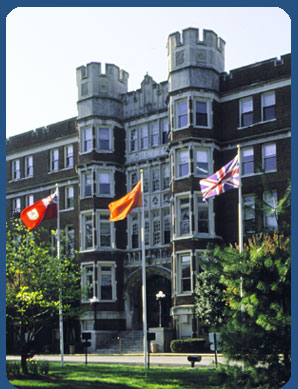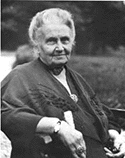| Women's Intellectual Contributions to the Study of Mind and Society Students, as part of an advanced seminar, examined and wrote about the lives of these women,
their intellectual contributions, and the unique impact and special problems that being female had
on their careers. |  |
| For information about referencing this paper - Click Here |
Maria Montessori (1870-1952)
by Tarraugh Flaherty

School and 'Education'
Her Curriculum
Bibliography
Early Life in Italy
During the same year that Italy became a unified, free nation one of
the worlds' greatest educators, Maria Montessori was born. She broke
traditional roles between male and female, teacher and student at a
very young age. She operated her life as though she could and would
effect it.
Her father, Alessandro Montessori, was a successful government
official and a member of the bourgeois civil service. Her mother,
Renide Stoppani, was a well educated, wealthy woman devoted to
liberation and unity of Italy. It was on this common ground that
Maria's parents met.
Due to a new position for Alessandro, the family made, what would
become, it's last move to Rome in 1875 when Maria was five years old.
The family's move from the more provincial town of, Ancona, to a
sophisticated and cosmopolitan Rome enabled Maria to have a better
education and the use of libraries and museums.
Her parents often differed on how to raise Maria. She was close with
her father until his death, but was clearly encouraged and supported
by her mother. Without her mother's well wishes she would have not
made the first move in her educational career to enter technical
school at the age of thirteen.
She began studies in engineering at the Regia Scuola Tecnica
Michelangelo Buovarroti. From this experience she began to model what
a school should not be like. She also made the decision not to
continue studies in engineering. Her relatives, friends, and father
were all relieved to here that she would veer away from such an
un-ladylike discipline.
School and 'Education'
What they didn't know was that Maria Montessori would instead go on to
study medicine, only to become the first female doctor of Italy.
Although there is some question as to Pope Leo XIII's involvement,
there is no real proof as to how or whom got Maria accepted into the
University of Rome's medical program. In fact, she graduated with a
score of 100 out of a possible 105 and the diploma was altered to fit
her gender in 1896.
A month after her graduation her life really took off. She was
immediately chosen to represent Italy in a Women's international
congress in Berlin. On return she was appointed to be the surgical
assistant at Santo Spirito. She was also working at the Children's
hospital and had a private practice.
In 1897 Montessori had a revelation. "I felt that mental deficiency
presented chiefly a pedagogical, rather than mainly a medical,
problem." The children she was working with could not be treated in
the hospitals they needed to be trained in schools. Given her new
insight she began to transfer her time towards perfecting education.
She wanted to use nature in the school in order to meet the real needs
of children. (The Montessori Method, 1912)
She developed an educational theory, which combined ideas of scholar
Froebel, anthropologist Giuseooe Sergi, French physicians, Jean Itard
and Edouard Seguin, with methods that she had found in medicine,
education, and anthropology. In 1900 she began to direct a small
school in Rome for 'challenged' youth. The methods she employed were
both experimental and miraculous. "We should really find the way to
teach the child how, before, before making him execute a task." She
suggested that teachers see themselves as social engineers, she
enhanced the scientific qualities of education. (The Montessori
Method)
In March of 1898, Montessori's only child, a son, Mario Montessori,
was born. Sometime earlier, she had had a love affair with her
colleague, Dr. Montesano. Together, they made a deal to keep the
relationship, and therefore the father's identity, a secret. In
exchange for the secrete neither of them agreed to ever marry another
person. Montesano, however, fell in love with and married, while still
working with Montessori in daily contact. It was the betrayal of this
promise that prompted her to leave the Orthophrenic School. Her son
was then sent to a wet nurse and later to a boarding school.
It was then in 1907 that Montessori began to assert her theories and
methods of pedagogy. She began by directing a system of daycare
centers for working class children in one of Rome's worst
neighborhoods.
The children entered her program as "wild and unruly". Much to her
surprise they began to respond to her teaching methods. She always
held them in the highest regard and taught her teachers to do
likewise. From the beginning amazing things happened. Children younger
than three and four years old began to read, write, and initiate
self-respect. The Montessori method encouraged what Maria saw as the
children's innate ability to 'absorb' culture. 3...And then we saw
them 'absorb' far more than reading and writhing...it was botany,
zoology, mathematics, geography, and all with the same ease,
spontaneously, and with out getting tired." (The Absorbent Mind)
Her Curriculum
Although her methods were criticized for being too detached, rigorous,
and even harsh for the youth, they did seem to facilitate a more
genuine, natural experience. She was often heard saying, "I studied my
children, and they taught me how to teach them." This may seem common
for us to do today, but Montessori was the first to view education in
this manner. She pioneered other attributes of what seems to be modern
education today.
A system of Math learning materials for very young children was
developed which allowed four and five year olds to explore their
interests where otherwise told they were too young. Montessori was
also the first in education to have child-sized tables and chairs made
for the students. She believed that the learning environment was just
as important as the learning itself. Because of this belief her
schools were often peaceful, orderly places, were the children valued
their space for concentration and the process of learning.
It was uncommon to treat children with such a high level of respect.
Back then society felt that children should be seen and not heard. "To
deny them (the children) the right to learn because we, as adults
think that they shouldn1t is illogical and typical of the way schools
have been run," she said at one time. Her methods completely
contradicted the educational theories and practice popular during her
day. On one occasion,
"SI decided to give the children a slightly humorous lesson on how to blow their noses. After I had shown them different ways to use a handkerchief, I ended by indicating how it could be done as unobtrusively as possible. I took out my handkerchief in such a way that they could hardly see it and blew my nose as softly as I could. The children watched me in rapt attention, but failed to laugh. I wondered why, but I had hardly finished my demonstration when they broke out into applause that
resembled a long repressed ovation in a theater. When I was on the point of leaving the school, the children began to shout, 'Thank you, thank you for the lesson!'"
Adults were often reprimanding kids about their running noses, but
never talking the time to teach them how to independently take care.
It's as if Montessori knew that they dealt with this situation, and
wanted to facilitate a more human experience for the students. On
another occasion, one of her teachers was late and the students
actually crawled through the window and got right to work. Montessori
also created the "game of silence," somewhat like meditation, where
each child was able to start the day with a sense of peace and focus.
After just a few times trying the game, they liked it.
During the remaining years of her life, from about 1907 to the
mid-1930's, Dr. Montessori devoted all of her time and energy to
developing schools throughout Europe and North America. She then
traveled to India and Sri Lanka, until 1947, where she trained
thousands of teachers the Montessori curriculum and methodology.
Bibliography
- Rita Kramer, Maria Montessori, Longman Canada Limited, 1976
- William Heard Kilpatrick Ph.D., The Montessori System Examined,
Arno Press Inc., 1971
- National Association for the Education of Young Children,
Montessori in Perspective N.A.E.Y.C., 1966
- Maria Montessori, Dr. Montessori's Own Handbook, Robert Bentley,
Inc., 1964
Back to Women's Page

